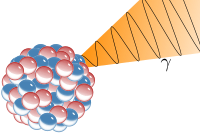
Photo from wikipedia
Abstract In this study, a comprehensive study on photon and fast neutron interactions was conducted to determine the possible uses of four different copper-based Nickel–Silver (NS) alloys as alternative protective… Click to show full abstract
Abstract In this study, a comprehensive study on photon and fast neutron interactions was conducted to determine the possible uses of four different copper-based Nickel–Silver (NS) alloys as alternative protective materials. For this purpose, photon interaction parameters (μ, μm, X1/2, σT, Zeff, Neff, Ceff) of NS alloys which have Cu65Ni18Zn17, Cu62Ni18Zn20, Cu64Ni12Zn24 and Cu55Ni18Zn27 compositions were presented experimentally in the photon energy range of 30–1333 keV using ideal transmission geometry conditions. In order to compare experimental and theoretical results and to a comprehensive evaluation in wide energy range (0.015–15 MeV), these parameters were also calculated using WinXCOM based Phy-X/PSD software. It was found that there is a good agreement between experimental and theoretical results, and that the maximum relative difference is approximately 1.2%. In order to test the suitability of the radiation shielding capacities of the studied alloys for nuclear applications, all parameters were also calculated theoretically for ordinary concrete (OC), basalt (BM) and steel magnetite (SM) concretes. Furthermore, the exposure build-up factors for the alloys and concretes were calculated using G-P fitting method at photon energy range from 0.015 to 15 MeV up to 40 mean free path (MFP) penetration depth. Moreover, the fast neutron removal cross-sections of the materials were determined using Phy-X/PSD software. According to the data obtained, it has been observed that the shielding capacities of NS alloys are far superior to selected concretes for both photon radiation and fast neutrons. It was revealed in this study that NS alloys may be an alternative shielding material candidate due to their high density, high melting points (about 1100 °C) and good mechanical strength.
Journal Title: Radiation Physics and Chemistry
Year Published: 2020
Link to full text (if available)
Share on Social Media: Sign Up to like & get
recommendations!